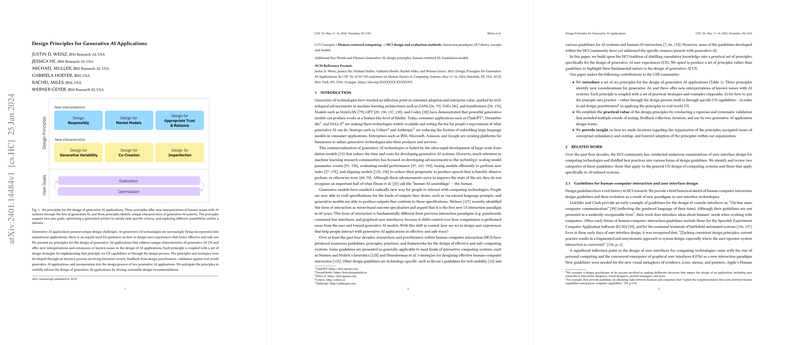Design Principles for Enhancing Generative AI Applications
The paper, Design Principles for Generative AI Applications, presents a structured analysis of design strategies necessary to create effective and user-friendly generative AI applications. As generative AI technologies are increasingly integrated into both consumer and enterprise applications, establishing effective design guidelines is crucial for creating user experiences that are both intuitive and beneficial. Authored by Justin D. Weisz and colleagues from IBM Research AI, the work introduces a framework of six design principles, each associated with practicable design strategies. These principles are derived from an iterative research process, involving a review of existing literature, feedback from design practitioners, and validation against existing generative AI applications.
Overview of Design Principles
The authors categorize their design principles into two groups: three principles offer new perspectives on the design challenges associated with AI systems, and three principles are unique to generative AI. This dual approach provides a comprehensive guideline framework for diverse scenarios.
- Design Responsibly: This principle emphasizes understanding real user needs over developing technology for its own sake. It stresses the importance of minimizing user harm and balancing stakeholder values.
- Design for Mental Models: Recognizing that users form mental models to understand systems, this principle includes strategies to help users effectively interact with generative AI. It includes orienting users to generative variability, teaching effective usage, and capturing user expectations.
- Design for Appropriate Trust {content} Reliance: This principle addresses the calibration of user trust, highlighting the importance of helping users discern when to rely on AI outputs. Strategies include making system capabilities clear, providing output rationales, and using design elements to prevent overreliance.
- Design for Generative Variability: Unique to generative AI, this principle addresses the variability in outputs produced by generative models. It includes strategies for leveraging multiple outputs and aiding users in managing and curating these outputs.
- Design for Co-Creation: This principle centers on fostering collaboration between users and AI in the creative process, allowing user influence over generative AI through thoughtful design of interaction modalities.
- Design for Imperfection: Acknowledging that AI outputs can be imperfect, this principle suggests designing features that allow users to recognize, evaluate, and improve imperfect outputs, helping them work constructively with AI imperfections.
Implications and Future Directions
This structured approach to designing generative AI applications not only enhances user experience but also mitigates potential risks, such as user reliance on flawed AI outputs or misinterpreted outputs due to poorly formed mental models. By focusing on user-centered design and responsible AI deployment, these principles aim to align AI development with user expectations and ethical standards.
The practical significance of these principles lies in their validated applicability across different stages of design—both in conceptual ideation and in evaluative stages within existing systems. This reinforces their potential utility for a wide range of AI-infused products. By establishing these foundational principles, the paper addresses a critical gap in existing human-AI interaction guidelines which have primarily focused on discriminative AI systems.
Moving forward, as generative AI technologies evolve, so too must these design principles. Future research could explore how these principles hold up across emerging generative AI technologies beyond the current scope, such as in AI-driven virtual reality applications or advanced interactive narrative systems. It also raises the opportunity for expanding these guidelines to integrate more deeply into the technical development processes, potentially influencing datasets, training processes, and model selection to be more closely aligned with end-user experiences.
Overall, the paper presents a pivotal advance in AI UX design, offering actionable insights that can significantly contribute to safer and more effective deployment of generative AI technologies in practice.
